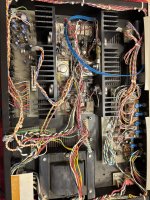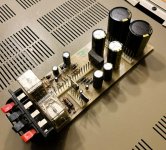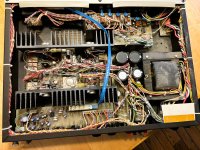A sound card would be extremely useful. But beware, they often have low tolerance for high input signal voltages. it's easy to blow them up. Resistive dividers (even a volume control) needs frequency compensation or it won't be flat. If it isn't flat there is no point.
The Quantasylum QA403 is an extremely inexpensive way to be able to make measurements accurately. If you can swing one, highly recommended. It produces test signals and measures them. Add those two devices up and it is paid for, add the scope to that price and you are way ahead of the game.
The Quantasylum QA403 is an extremely inexpensive way to be able to make measurements accurately. If you can swing one, highly recommended. It produces test signals and measures them. Add those two devices up and it is paid for, add the scope to that price and you are way ahead of the game.
I can not understand why andybody would want to recommend an advanced measuring system to a guy who never used a scope and signal gen.
If it's a reasonably learnable task, I'd sure like to try it. It seems a useful skill. Audio's been a hobby for a long time....I've soldered, designed ,built , and modified many speakers, rebuilt tube amps, done mods, phono stages, power supplies, etc.,, so I've at least sniffed around inside an amp before. I've just never used a scope to get useful information. I'll be retiring this year, and the diagnostics is something I'd like to learn.
The QA403 is easy to use. It happens to be extremely good as well. The price is right and you could easily spend far more. I spend $2,500 on a THD meter earlier in time, not even HP.
A scope is a basic piece of equipment, an audio analyser or THD meter is also basic. The QA403 generates signals with low distortion as well. It is a no-brainer. You use it with your computer and software.
A scope is a basic piece of equipment, an audio analyser or THD meter is also basic. The QA403 generates signals with low distortion as well. It is a no-brainer. You use it with your computer and software.
Where can you buy one of these?A sound card would be extremely useful. But beware, they often have low tolerance for high input signal voltages. it's easy to blow them up. Resistive dividers (even a volume control) needs frequency compensation or it won't be flat. If it isn't flat there is no point.
The Quantasylum QA403 is an extremely inexpensive way to be able to make measurements accurately. If you can swing one, highly recommended. It produces test signals and measures them. Add those two devices up and it is paid for, add the scope to that price and you are way ahead of the game.
One could have guessed quantasylum.com and gotten there without telling Google you’re thinking about buying test equipment…..
Hi wg_ski,
Absolutely true. But I was in a hurry, so I "Googled it" knowing I would get the right spot on the net. I have very limited time.
Absolutely true. But I was in a hurry, so I "Googled it" knowing I would get the right spot on the net. I have very limited time.
lol!
I already get endless ads for those. > $30K is a bit rich for what it does, the software is also far too expensive. The Keysight U8903B has a 1.5 MHz option and is priced similarly.
I've been wanting to take the Keysight model out for a test spin.
I already get endless ads for those. > $30K is a bit rich for what it does, the software is also far too expensive. The Keysight U8903B has a 1.5 MHz option and is priced similarly.
I've been wanting to take the Keysight model out for a test spin.
I wouldn't know what class G/H looked like unless it was labeled, but I do have pics in case they helpYou probably already get inundated with ads for $30,000 audio analyzers anyway. Nothin’ to lose.
On the subject of the actual amplifier, does this one use a class G/H power supply, or just a regular pair of rails? I’ve never had my head inside this particular one.


 :
:Can’t be sure without a schematic or some sleuthing with a meter. But I do see multiple pairs of big caps and a pair of switching darlingtons that would otherwise be out of place. Playing fine at low volumes but clipping way the hell early is a symptom of losing an upper rail in an H or G class design. I’ve had it happen in my Behringer EP2500 twice. I’ve also serviced NADs and Carver cubes that had it happen.
It does look like it may switch the rails, but I haven't seen any manuals in the wild unless you buy them.
Normally things are pretty loud before the rails switch up.
The Cube was a nasty little amplifier, I hate working on them. I will say it isn't usual for the rails to not switch. If anything, I've seen them in the "locked up" state where they don't turn off. A shorted commutator transistor is the most common issue. Honestly, the typical failure (non-Carver) is shorted output(s) and maybe a shorted commutator. If Carver amps lose an output, usually they just shut down safely.
Normally things are pretty loud before the rails switch up.
The Cube was a nasty little amplifier, I hate working on them. I will say it isn't usual for the rails to not switch. If anything, I've seen them in the "locked up" state where they don't turn off. A shorted commutator transistor is the most common issue. Honestly, the typical failure (non-Carver) is shorted output(s) and maybe a shorted commutator. If Carver amps lose an output, usually they just shut down safely.
The Phase Linear DRS series was introduced in 1982 at a time when Phase Linear was struggling to survive. DRS stands for “Dynamic Range System”.
“Phase Linear was evidently looking ahead to the anticipated growth of digital and other recording systems with large dynamic-range requirements when they designed the DRS series of amplifiers”. (Stereo Review magazine). Former Phase Linear head engineer A.P. Van Meter also told me many years ago that they were working on this technology in order to meet the "FTC required one-third power preconditioning".
The DRS250 is an integrated amplifier version of the DRS400 amplifier. They both share the same “PWR DRIVE” (210-0371) and “PWR SW” (210-0409) pc boards as well as a number of other parts including the same power supply transformer. NOTE: The power supply transformer had a higher than normal failure rate.
The DRS250 and DRS400 “work on a multiple power supply basis. It provides 50 Watts per channel RMS into 8 ohms at the minimum output level. But when your music reaches it loudest passages, The DRS 250 and DRS400 automatically delivers up to 400 Watts of peak power per channel or another 6.02dB of headroom.”
The service manuals for the DRS250 and DRS400 were written at a time when Phase Linear was downsizing and therefore are not as extensive as earlier series 1 and series 2 service manuals were. They include schematics, parts layout, specifications, parts list, and a 1 page “Amplifier Test Procedure”. NOTE: There are no troubleshooting tips.
Step 3 in the service manual states: “Display: monitor the L channel output with an AC voltmeter (no load). Drive the L channel with a 2KHz sine wave. Verify that the DRS indicator lights at 50 Watts RMS (20.0 VRMS) and that the clipping indicator lights at 200 Watts RMS (40 VRMS). Repeat for R. channel.”
Step 9 “Supply switching: Drive both channels with a 2KHz sine wave, increase the level and verify supply switching at the collector (case) of the positive and negative banks. Low supply voltage +/-50VDC, high supply voltage +/-80VDC
NOTE: The MJ1101x series Darlingtons in the DRS series amplifiers had a higher than normal failure rate.
“Phase Linear was evidently looking ahead to the anticipated growth of digital and other recording systems with large dynamic-range requirements when they designed the DRS series of amplifiers”. (Stereo Review magazine). Former Phase Linear head engineer A.P. Van Meter also told me many years ago that they were working on this technology in order to meet the "FTC required one-third power preconditioning".
The DRS250 is an integrated amplifier version of the DRS400 amplifier. They both share the same “PWR DRIVE” (210-0371) and “PWR SW” (210-0409) pc boards as well as a number of other parts including the same power supply transformer. NOTE: The power supply transformer had a higher than normal failure rate.
The DRS250 and DRS400 “work on a multiple power supply basis. It provides 50 Watts per channel RMS into 8 ohms at the minimum output level. But when your music reaches it loudest passages, The DRS 250 and DRS400 automatically delivers up to 400 Watts of peak power per channel or another 6.02dB of headroom.”
The service manuals for the DRS250 and DRS400 were written at a time when Phase Linear was downsizing and therefore are not as extensive as earlier series 1 and series 2 service manuals were. They include schematics, parts layout, specifications, parts list, and a 1 page “Amplifier Test Procedure”. NOTE: There are no troubleshooting tips.
Step 3 in the service manual states: “Display: monitor the L channel output with an AC voltmeter (no load). Drive the L channel with a 2KHz sine wave. Verify that the DRS indicator lights at 50 Watts RMS (20.0 VRMS) and that the clipping indicator lights at 200 Watts RMS (40 VRMS). Repeat for R. channel.”
Step 9 “Supply switching: Drive both channels with a 2KHz sine wave, increase the level and verify supply switching at the collector (case) of the positive and negative banks. Low supply voltage +/-50VDC, high supply voltage +/-80VDC
NOTE: The MJ1101x series Darlingtons in the DRS series amplifiers had a higher than normal failure rate.
The build quality is night and day between the M1.0/1.5 and the “cube”. Now those cubes were the definition of unreliable. Sounds like these amps were also full of problems.
Much later designs buy the Big Boys (QSC, Peavey/Crest, Crown) simply designed their commutators to run ALL THE TIME, even able to track at 20 kHz. Much lower failure rates.
Much later designs buy the Big Boys (QSC, Peavey/Crest, Crown) simply designed their commutators to run ALL THE TIME, even able to track at 20 kHz. Much lower failure rates.
- Home
- Amplifiers
- Solid State
- Causes of Amp Distorion - Phase Linear DRS250